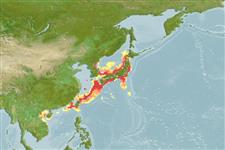>
Albuliformes (Bonefishes) >
Albulidae (Bonefishes) > Pterothrissinae
Etymology: Pterothrissus: Greek,pteron = wing, fin + Greek, thrissa, -es = shad (Ref. 45335).
More on author: Hilgendorf.
Environment: milieu / climate zone / depth range / distribution range
Écologie
marin benthopélagique; profondeur 147 - 1000 m (Ref. 50610). Temperate; 49°N - 15°N, 105°E - 149°E
Northwest Pacific: Japan (Ref. 559), China (Ref. 47439) and Russia (56557).
Taille / Poids / Âge
Maturity: Lm ? range ? - ? cm
Max length : 50.0 cm TL mâle / non sexé; (Ref. 56557)
Épines dorsales (Total): 0; Rayons mous dorsaux (Total): 54-65; Épines anales 0; Rayons mous anaux: 10 - 13; Vertèbres: 105 - 107. This species is distinguished by the following set of characters (holotype measurements in parentheses): supraneural bones 6-7; dorsal-fin rays 54-65 (mode 58); total vertebrae 105-107 (107); pored lateral-line scales 99-109 (105); pre-dorsal scale rows 13-20 (16); head length 23-31 % (mean 27 %) of SL; pectoral-fin length 10-18 % (15 %) of SL; pre-dorsal-fin length 31-39 % (35 %) of SL; dorsal-fin base length 47-56 % (52 %) of SL; postorbital length 9-12 % (10 %) of SL; upper caudal-fin length 16-32 % (21 %) of SL (Ref. 109573).
Found in deep waters.
Life cycle and mating behavior
Maturité | Reproduction | Frai | Œufs | Fécondité | Larves
Spawning occurs in open waters. Eggs are pelagic (Ref. 205).
Masuda, H., K. Amaoka, C. Araga, T. Uyeno and T. Yoshino, 1984. The fishes of the Japanese Archipelago. Vol. 1. Tokai University Press, Tokyo, Japan. 437 p. (text). (Ref. 559)
Statut dans la liste rouge de l'IUCN (Ref. 130435)
Menace pour l'homme
Harmless
Utilisations par l'homme
Plus d'informations
RéférencesAquacultureProfil d'aquacultureSouchesGénétiqueElectrophoresesHéritabilitéPathologiesTraitementNutrientsMass conversion
CollaborateursImagesStamps, Coins Misc.SonsCiguateraVitesseType de nageSurface branchialeOtolithesCerveauxVision
Outils
Articles particuliers
Télécharger en XML
Sources Internet
Estimates based on models
Preferred temperature (Ref.
123201): 0.6 - 13.8, mean 8.6 °C (based on 65 cells).
Phylogenetic diversity index (Ref.
82804): PD
50 = 1.0002 [Uniqueness, from 0.5 = low to 2.0 = high].
Bayesian length-weight: a=0.01122 (0.00514 - 0.02450), b=3.04 (2.87 - 3.21), in cm total length, based on all LWR estimates for this body shape (Ref.
93245).
Niveau trophique (Ref.
69278): 3.3 ±0.2 se; based on diet studies.
Résilience (Ref.
120179): Milieu, temps minimum de doublement de population : 1,4 à 4,4 années (Preliminary K or Fecundity.).
Fishing Vulnerability (Ref.
59153): Moderate vulnerability (40 of 100).
